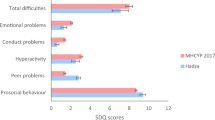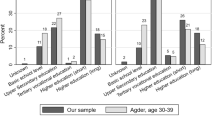Abstract
Epidemiological information about prevalence of child mental health problems is essential to inform policy and public health practice. This information is weak in many developing countries and those in developmental transition. There have been few such studies in Arab countries and none in Egypt. We conducted a population prevalence study of emotional and behavioural disorders among 1186 6–12 year old children in Minia, Egypt. Data was collected from teachers and parents using the Strengths and Difficulties Questionnaire with a 98 and 91% response respectively. Prevalence of abnormal symptom scores is reported for both parents and teachers. Prevalence of probable psychiatric diagnoses was measured using the SDQ multi-informant algorithm. These prevalences have then been compared to published UK data. The prevalence of emotional and behavioural symptoms was high as reported by both parents and teachers (Abnormal total difficulties: teachers 34.7% (95% CI 32.0–37.5), parents 20.6% (18.2–23.2). Abnormal prosocial scores: teachers 24.9% (22.5–27.5), parents 11.8% (9.9–13.9)) but prevalence of probable psychiatric diagnoses was much lower (Any psychiatric diagnosis 8.5% (6.9–10.5); Emotional disorder 2.0% (1.2–3.0); Conduct disorder 6.6% (5.1–8.3); Hyperactivity disorder 0.7% (0.3–1.4)). Comparison with UK data showed higher rates of symptoms but similar rates of probable disorders. Despite public, professional and political underestimation of child mental health problems in Egypt, rates of symptoms are higher than in developed countries, and rates of disorders are comparable. These findings support greater investment in community and primary care prevention and treatment initiatives.
Similar content being viewed by others
References
Abd-Elhamid A. Child mental health in Egypt: Present practice and future needs. (MSc Thesis). University of Nottingham, UK. 2003
Abou Nazel MW, Fahmy SI, Younnis IA, Seif el-Din AG, Abdel Fatah M, Mokhtar S et al (1991) A study of depression among Alexandria preparatory school adolescents. J Egypt Public Health Assoc 66:649–674
Afifi MM (2005) Mental health publications from the Arab world cited in PubMed, 1987–2002. East Mediterr Health J 11(3):319–328
Almaqrami MH, Shuwail AY (2004) Validity of the self-report version of the strengths and difficulties questionnaire in Yemen. Saudi Med J 25:592–601
Alyahri A, Goodman R (2006) Validation of th Arabic strengths and difficulties questionnaire and the development and well-being assessment. East Mediterr Health J 12(Suppl 2):S138–S146
Alyahri A, Goodman R (2008) The prevalence of DSM-IV psychiatric disorders among 7–10 year old Yemeni schoolchildren. Soc Psychiatry Psychiatr Epidemiol 43:224–230
Bird HR, Canino G, Rubio-Stipec M, Gould MS, Ribera J, Sesman M, Woodbury M, Huertas-Goldman S, Pagan A, Sanchez-Lacay A et al (1988) Estimates of the prevalence of childhood maladjustment in a community survey in Puerto Rico. The use of combined measures. Arch Gen Psychiatry 45(12):1120–1126
Costello EJ, Egger H, Angold A (2005) 10-year research update review: the epidemiology of child and adolescent psychiatric disorders: I. Methods and public health burden. J Am Acad Child Adolesc Psychiatry 44(10):972–986
Eapen V, al-Gazali L, Bin-Othman S, Abou-Saleh M (1998) Mental health problems among schoolchildren in United Arab Emirates: prevalence and risk factors. J Am Acad Child Adolesc Psychiatry 37(8):880–886
Eapen V, Ghubash R (2004) Help-seeking for mental health problems of children: preference and attitudes in the United Arab Emirates. Psychol Rep 94(2):663–667
Fayyad JA, Jahshan CS, Karam EG (2001) Systems development of child mental health services in developing countries. Child Adolesc Psychiatr Clin N Am 10(4):745–762
Goodman R (1997) The strengths and difficulties questionnaire: a research note. J Child Psychol Psychiatry 38:581–586
Goodman R (1999) The extended strengths and difficulties questionnaire as a guide to child psychiatric caseness and consequent burden. J Child Psychol Psychiatry 40:791–799
Goodman R, Ford T, Simmons H, Gatward R, Meltzer H (2000) Using the strengths and difficulties questionnaire (SDQ) to screen for child psychiatric disorders in a community sample. Br J Psychiatry 177:534–539
Goodman R, Renfrew D, Mullick MSI (2000) Predicting type of psychiatric disorder from strengths and difficulties questionnaire (SDQ) scores in child mental health clinics in London and Dhaka. Eur Child Adolesc Psychiatry 9:129–134
Harper G (2001) Cultural influences on diagnosis. Child Adolesc Psychiatr Clin N Am 10(4):711–728
Herrman H, Swartz L (2007) Promotion of mental health in poorly resourced countries. Lancet 370:1195–1197
Mathai J, Anderson P, Bourne A (2004) Comparing psychiatric diagnoses generated by the strengths and difficulties questionnaire with diagnoses made by clinicians. Aust NZ J Psychiatry 38:639–643
Meltzer H, Gatward R, Goodman R, Ford T (2000) Mental health of children, adolescents in Great Britain. The Stationary Office, London
Mullick MS, Goodman R (2001) Questionnaire screening for mental health problems in Bangladeshi children: a preliminary study. Soc Psychiatry Psychiatr Epidemiol 36(2):94–99
Mullick MS, Goodman R (2005) The prevalence of psychiatric disorders among 5–10 year olds in rural, urban, slum areas in Bangladesh: an exploratory study. Soc Psychiatry Psychiatr Epidemiol 40(8):663–671
Okasha A (2004) Focus on psychiatry in Egypt. British Journal of Psychiatry 185:266–272
Okasha A, Bishri Z, Seif el Dawla A et al (1999) Anxiety symptoms in an Egyptian sample: children and adolescents. Curr Psychiatry 6:356–368
Patel V, Araya R, Chatterjee S, Chisholm D, Cohen A, De Silva M, Hosman C, McGuire H, Rojas G, van Ommeren M (2007) Treatment and prevention of mental disorders in low-income and middle-income countries. Lancet 370: 991–1005
Patel V, Flisher AJ, Hetrik S, McGorry P (2007) Mental health of young people: a global public-health challenge. Lancet 369:1302–1313
Rahim SIA, Cederblad M (1986) Effects of rapid urbanization on child behaviour and health in a part of Khartoum, Sudan—II. Psycho-social influences on behaviour. Soc Sci Med 22:723–730
Rahman A, Mubbashar M, Harrington R, Gater R (2000) Developing child mental health services in developing countries. J Child Psychol Psychiatry 41(5):539–546
Roberts RE, Attkisson CC, Rosenblatt A (1998) Prevalence of psychopathology among children and adolescents. Am J Psychiatry 155:715–725
Rudan I, Lawn J, Cousens S, Rowe AK, Boschi-Pinto C, Tomasković L, Mendoza W, Lanata CF, Roca-Feltrer A, Carneiro I, Schellenberg JA, Polasek O, Weber M, Bryce J, Morris SS, Black RE, Campbell H (2005) Gaps in policy-relevant information on burden of disease in children: a systematic review. Lancet 365:2031–2040
Samad L, Hollis C, Prince M, Goodman R (2005) Child and adolescent psychopathology in a developing country: testing the validity of the strengths and difficulties questionnaire (urdu version). Int J Methods Psychiatr Res 14(3):158–166
Thabet AA, Stretch D, Vostanis P (2000) Child mental health problems in Arab children: application of the strengths and difficulties questionnaire. Int J Soc Psychiatry 46(4):266–280
Thabet AAM, Vostanis P (2005) Child mental health problems in the Gaza strip. Isr J Psychiatry Related Res 42(2):84–87
Timimi S (2005) Effect of globalisation on children’s mental health BMJ 331:37–39 doi:10.1136/bmj.331.7507.37
UNESCO (2008) Institute for statistics. http://stats.uis.unesco.org/unesco/TableViewer/tableView.aspx?ReportId=184. Accessed 14 Jan 2008
Vostanis P (2006) Strengths and difficulties questionnaire: research and clinical applications. Curr Opin Psychiatry 19:367–372
World Bank (2007) World Bank health, nutrition and population statistics. http://devdata.worldbank.org/hnpstats/default.htm. Accessed 17 Jul 2007
Acknowledgments
We are grateful to all the teachers and parents of children in Minia who filled in the questionnaires, to the school staff who helped distribute and administer the questionnaires and to the head teachers of the individual schools and the director of Minia Regional Education authority who agreed to collaborate with the study. We thank Professor Robert Goodman for advice about the use and analysis of the Strengths and Difficulties Questionnaire. Dr. Louise Swift for providing statistical advice. This work contributed towards an MD degree at the University of East Anglia, UK, by the first author who self funded her studies.
Author information
Authors and Affiliations
Corresponding author
Rights and permissions
About this article
Cite this article
Elhamid, A.A., Howe, A. & Reading, R. Prevalence of emotional and behavioural problems among 6–12 year old children in Egypt. Soc Psychiat Epidemiol 44, 8–14 (2009). https://doi.org/10.1007/s00127-008-0394-1
Received:
Accepted:
Published:
Issue Date:
DOI: https://doi.org/10.1007/s00127-008-0394-1




